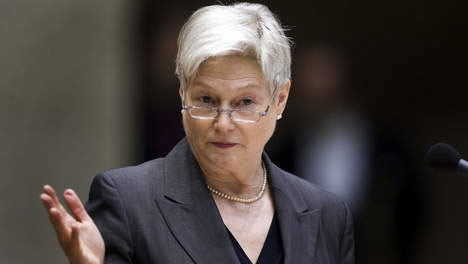Nuclear energy still has a place in the future
The head of the International Energy Agency (IEA) said yesterday that humans still need atomic energy despite the crisis at Japan's Fukushima I power plant and the intention to abandon some nuclear energy. country.
AFP reported that Maria van der Hoeven, who recently took over as CEO of the IEA on September 1, said that some countries would not be able to meet the demand for electricity consumption if they shut down nuclear power plants. multiply. In cases where countries want to replace nuclear energy with renewable energy (wind, sunlight, tide), they must accept the fact that renewable energy cannot meet the demand for electricity in the future. near future.
'How effective is the renewable energy? How high is the level of renewable energy utilization in the current period? What will we do to make renewable energy rapidly account for a large share of the energy market supply? ' , Ms. Van der Hoeven said.

Maria van der Hoeven. (Photo: parool.nl)
Japan is still addressing the aftermath of the crisis at the Fukushima I. nuclear power plant. The crisis arises because the system cools down the crippled reactors after the March 11 earthquake and tsunami. Because water does not reach the reactors, nuclear fuel melts and leaks out.
After the incident in Japan, Germany closed many nuclear power plants. The German government also decided to abandon nuclear energy by 2022.
Recently the Italian parliament rejected the plan to restart the nuclear program of Prime Minister Silvio Berlusconi. The move shows that the Italian legislators are still afraid of atomic energy after the crisis at the Fukushima I. power plant.
In May, the Swiss government also announced that it would consider the possibility of giving up nuclear energy.
However, Ms. Van der Hoeven affirmed that nuclear energy is still necessary for the future of humanity."If people want to reduce CO2 in the future, we have only three practical choices: nuclear energy, renewable energy and gas , " she said.
All current renewable energy technologies still produce greenhouse gas emissions. For example, wind turbines do not generate emissions during operation, but humans create CO2 in the production, maintenance and installation of turbines.
Gas still produces CO2, but the amount of carbon dioxide produced by gas is only half that of coal.
Nuclear power plants can produce carbon dioxide during construction, but do not generate that gas during operation.
- Europe's first thorium-powered nuclear power plant has been activated after more than 40 years
- Japan wants to erase nuclear power
- Energy for the future
- Thorium material: Super safe future nuclear energy
- History of formation and development of nuclear energy
- Benefits and harms when producing electricity from nuclear energy
- China invested in building 5 nuclear plants in the UK
- Russia develops a nuclear power engine that takes people to Mars for 45 days
- Russian-Vietnamese cooperation to develop nuclear power
- how to behave with nuclear power?
- We have endless energy, but why haven't we used it yet?
- Vietnam will use responsible nuclear energy
 'Barefoot engineer' invents a pipeless pump
'Barefoot engineer' invents a pipeless pump Process of handling dead pigs due to disease
Process of handling dead pigs due to disease Radiometer
Radiometer Warp Engine: Technology brings us closer to the speed of light
Warp Engine: Technology brings us closer to the speed of light